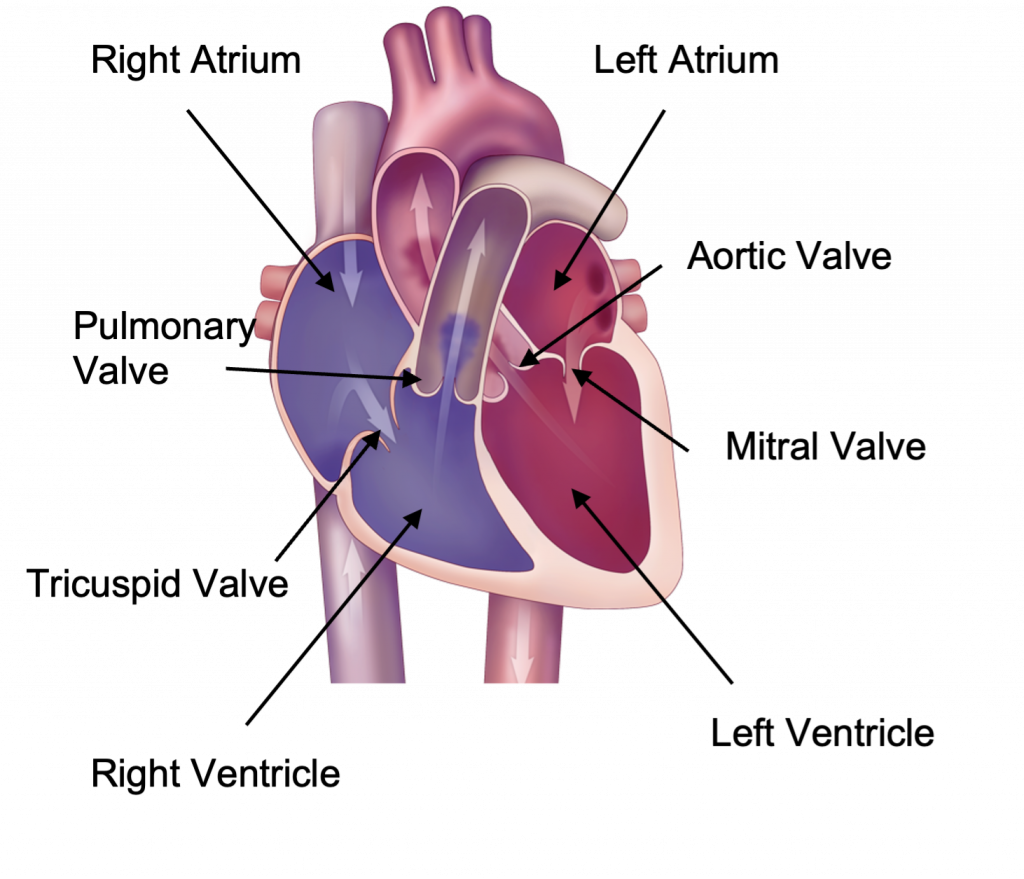
As we age, our organs also begin to show signs of ageing. And one of the most vital organs in our body that is also susceptible to ageing, is the heart. Not being obvious to the naked eye, one often may misread the symptoms of an aging heart to be normal and dismiss the warning signs. As we grow older, the conditions of our hearts also go through the process of wear and tear, and the prolonged stressful lifestyle habits may not be the best activities for the heart.
The heart has four valves – the aortic valve, tricuspid valve, pulmonary valve, and mitral valve. In order of blood circulation, the valves are:
1. Tricuspid Valve
– Has three leaflets or cusps
– Separates the top right chamber (right atrium) from the bottom right chamber (right ventricle)
– Opens to allow blood to flow from the right atrium to the right ventricle
– Prevents the backflow of blood from the right ventricle to the right atrium
2. Pulmonary Valve (or Pulmonic Valve)
– Has three leaflets
– Separates the right ventricle from the pulmonary artery
– Opens to allow blood to be pumped from the right ventricle to the lungs (through the pulmonary artery) where it will receive oxygen
– Prevents the backflow of blood from the pulmonary artery to the right ventricle
3. Mitral Valve
– Has two leaflets
– Separates the top left chamber (left atrium) from the bottom left chamber (left ventricle)
– Opens to allow blood to flow from the left atrium to the left ventricle
– Prevents the backflow of blood from the left ventricle to the left atrium
4. Aortic Valve
– Has three leaflets, unless it’s abnormal from birth, i.e. bicuspid (two leaflet) aortic valve
– Separates the left ventricle from the aorta
– Opens to allow blood to leave the heart from the left ventricle through the aorta and the body
– Prevents the backflow of blood from the aorta to the left ventricle

The most common heart ailment that most people are aware of is the heart attack (caused by blockage of the artery supplying the heart muscle). However, there is more than just heart attack in heart diseases. One of the silent killers is heart valve disease, which is commonly misunderstood by patients as normal signs of ageing. But sometimes, these changes may be signs and symptoms of an underlying medical condition, such as the most common heart valve disease – aortic stenosis.
Aortic Stenosis is the narrowing of the aortic valve opening, which is caused by calcium deposits and or hardening of the valves. It restricts the blood flow from the left ventricle to the aorta and may also affect the blood pressure in the left atrium, It prevents blood from flowing easily throughout your body, meaning your body does not get the proper amount of oxygen it needs. The heart may need to work harder to pump blood throughout the body, and often, it can’t do so effectively. When that happens, some people may notice uncomfortable symptoms like shortness of breath and fatigue as the heart becomes weaker. There may not be any outward symptoms until the disease becomes severe, which may then be life-threatening and will progress rapidly, leading to longer term consequences.
The individuals mostly affected by the disease are the elderly. It is estimated that 12.4% of people over age 75 have Aortic Stenosis. Common symptoms of Aortic Stenosis include:
: swollen ankles / feet
: feel breathless, dizziness, and or tiredness
: have difficulty in walking or exercising
: experience chest pains, rapid or irregular heartbeats or heart murmurs
: shortness of breath
: fatigue (low energy)
: rapid, fluttering heartbeat
: difficulty sleeping or needing to sleep sitting up
: decline in activity level or reduced ability to do normal activity
It is important to note the symptoms of Aortic Stenosis as many sufferers do not realise until it is sometimes too late.

happy asian old couple jogging running outdoors in park
Aortic Stenosis is a progressive condition that causes the narrowing of the aortic valve opening, restricting blood flow from the left ventricle to the aorta, which in return, may also affect the pressure in the left atrium, and eventually cause heart failure. When the valve is damaged, it leads to its stiffening and inability to open and close adequately.
Risk factors for Aortic Stenosis include increasing age, high blood pressure, high cholesterol, smoking, deformed aortic valve and family history.
In Singapore, 120 in 1 million people are being treated for Aortic Stenosis, and 50% of untreated patients tend to die from the condition within 2 years of being diagnosed.
Aortic Stenosis is easily diagnosed through two common methods:
1. Auscultation – done by using the stethoscope to pick up heart murmurs
2. Echocardiogram – ultrasound scan of the heart. If the echo picks up on any abnormalities, doctors will send the patient for further tests
After being diagnosed through the above methods, there are 2 treatment options available for Aortic Stenosis. Medications can only address or relieve the symptoms, and cannot treat the condition on its own.
1. Surgical Aortic Valve Replacement
A surgical aortic valve replacement is more invasive and requires an open-heart surgery to treat severe Aortic Stenosis. However, some of the patients are not referred for the operation because of their risk of going through a surgery. Most open heart surgeries are performed through an incision across the full length of the breast bone or sternum. Occasionally, it also can be performed through smaller incisions. Open heart surgeries, including those performed through smaller incisions, require the use of a heart lung machine which temporarily takes over the function of the heart. During the procedure, the surgeon will completely remove the diseased aortic valve and insert a new one in; either a mechanical valve (made of man-made material) or biological (made of animal
or human tissues).
2. Transcatheter Aortic Valve Implantation (TAVI)
TAVI may be a better option for people who have been diagnosed with severe Aortic Stenosis depending on their risk for open-heart surgery. TAVI (sometimes called transcather aortic valve replacement or TAVR) is a less-invasive procedure than open- heart surgeries. It is technically not considered a replacement because the valve is not actually replaced but has a new one implanted within the native diseased valve. TAVI can be done with 4 access routes, depending on the body’s condition, by inserting the catheter into a blood vessel to guide it into the heart. The most frequently used access route is the transfemoral approach, where the catheter is inserted through the leg. If transfemoral access is not possible, alternative routes are transapical, through the bottom tip of the heart, transaortic, through a large blood vessel in the heart, or trans- subclavian, through the subclavian artery.

On 2nd July 2022, Saturday, from 2PM – 4PM, Edwards Lifesciences is organizing the Heart Health Series titled Get To Know Your Heart for attendees to learn more about their heart and structure, and how important it is to care for their heart health. This is done in partnership with Mount Elizabeth and Dr Paul Chiam, Senior Consultant Cardiologist at The Heart & Vascular Centre, Mount Elizabeth, at Mount Elizabeth Novena Conference Room.
Dr Chiam is a Cardiologist specializing in Interventional Cardiology, and is an Adjunct Associate Professor at the National University of Singapore, Yong Loo Lin School of Medicine, and a Visiting Consultant at the National University Heart Centre Singapore, and Ng Teng Fong General Hospital Singapore. Dr Chiam had led a team that performed the first TAVI in Asia in 2009. He performs minimally invasive heart valve therapies, complex coronary angioplasty, peripheral artery angioplasty, and carotid artery stenting.
During the talk, Dr Chiam will talk about the different heart disease we are susceptible to, and how Aortic Stenosis is one of the rising silent killers. Attendees will be able to understand the structure of the heart and valves, find out more about what can happen with an ageing heart, the symptoms of an unwell heart, what treatments and options are available for patients going through the disease and how to care for the heart.
Joining Dr Chiam will be Ms Diane Seto, Senior Dietitian at Mount Elizabeth Hospital. With over six years of working experience as a clinical dietitian, she has wide experience in seeing patients with a variety of conditions including cardiovascular disease, diabetes, and obesity. Aside from clinical work, Ms Seto also provides nutrition education to healthcare professionals and the community. She holds a Bachelor’s Degree in Nutrition and Dietics (with Honours) from Monash University in Australia and is a Registered Dietitian with the Singapore Nutrition and Dietetics Association. She believes health and wellbeing is a holisticexperience combining a healthy diet and active lifestyle, and is passionate about encouraging individuals to achieve good health through these means.
 During the talk, attendees will be able to find out if there is truly something like an ideal diet for good heart health, and find out what exactly these foods are and what are the practice ways to achieve them.
During the talk, attendees will be able to find out if there is truly something like an ideal diet for good heart health, and find out what exactly these foods are and what are the practice ways to achieve them.
Members of the public who are interested in Dr Paul Chiam and Ms Diane Seto’s Heart Health Series talk, may scan the QR code or visit https://bit.ly/3xwTqrQ to register their interest for FREE. They will also receive a free goody bag and refreshments for the event.







